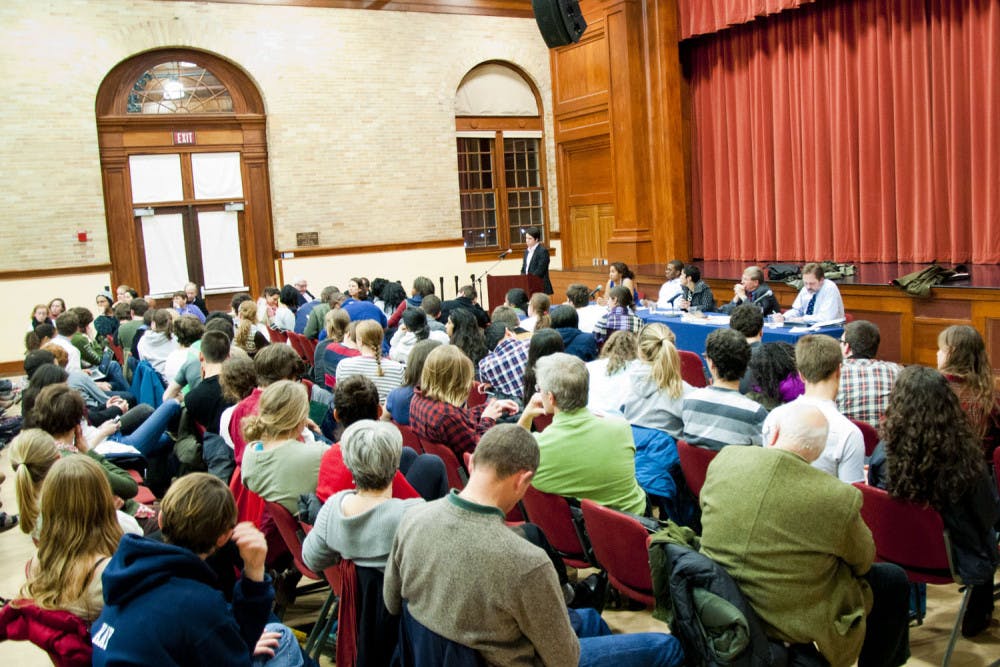On Tuesday, Nov. 27 at 7 PM., the Student Government Association (SGA) sponsored an Affirmative Action panel in the McCullough Social Space. The panel, which consisted of Dean of the College Shirley Collado, Dean of Admissions Greg Buckles, Charles A. Dana Professor of Political Science Murray Dry and students Kim Banford ’15 and Andrew Snow ’15, met to discuss the implications of affirmative action in collegiate institutions, particularly at the College, in the light of the Fisher v. University of Texas case currently before the Supreme Court.
The College supports affirmative action as a way to create a more diverse student body. In cooperation with 36 other colleges and universities, the College produced the amici curiae briefs, which were presented to the Supreme Court in favor of affirmative action.
“Highly selective institutions cannot obtain the diversity they seek except by seeking it directly,” argued the brief.
Yet, as Collado explained at the panel, the current language and processes of affirmative action are unsophisticated, and oftentimes this language lends itself to promoting “cosmetic diversity,” or simply creating a critical mass of students who may be considered “diverse”.
Dry and Buckles offered two future alternatives to affirmative action during the panel. Dry, an opponent of affirmative action, suggested that affirmative action does not have a place in college admissions and instead the focus ought to be on the educational disparity among different races. Buckles proposed that colleges could use socioeconomic class as a factor in the admissions decision, in place of race, as part of the attempt to obtain a diverse student body.
Buckles went on to explain that the College has no caps or quotas in regards to race, and instead uses a holistic admissions approach that considers race as one factor among many when considering applicants.
The College has undertaken efforts to not only increase diversity among its student body, but also among its applicant pool. In order to foster a heterogeneous body of applicants from which to select accepted students, the College created the Discover Middlebury program, which flies high school students to Middlebury for an overnight visit in an attempt to make the campus accessible to a greater number of people. In addition, the College also works with the Posse Foundation to add diversity to campus.
Banford suggested that the Posse Foundation is one of the main reasons the College has a diverse student body.
“If you took away all of the Posse scholars, Middlebury would look drastically different,” said Banford.
Despite the holistic attempts at achieving diversity, many in attendance at the panel agreed that a stereotype of a typical student continues to exist on campus.
“My idea of the Midd Kid is that they are basically good-looking and they are very studious,” said Dry. “And it doesn’t matter if they are students of color or not.”
Still, as Alan Sutton ’14 pointed out, that stereotype, while not related to race, is nonetheless formed through superficial observation.
“Good-looking, that’s a concept that still [uses] visual language,” said Sutton.
In dialogue between audience members and panelists, students and faculty audience members agreed that the stereotypical qualities of embodied by a so-called “typical” student must be re-imagined before true diversity can be achieved among the student body.
Professor of Dance Christal Brown, the only African American female faculty member at the College, explained at the panel that the concept of diversity is closely linked with the goals of a liberal arts education.
“[A liberal arts education] is about unearthing all types of stereotypes,” Brown reminded the audience.
Anthony Perez ’14 felt, however, that the College falls short of its attempts to diversify the student body.
“Middlebury could do a little bit more to break down that stereotype that only one type of student comes here,” said Perez.
Numbers suggest that more than one type of student do come to the College. Buckles said that of the current first-year class, students who self-identified as students of color on their applications make up 20 percent of the student body. Additionally, international students comprise about 11 percent of first-years, a number which is far greater than that at many of the College’s peer institutions.
The audience and panelists agreed, however, that the College must make a conscious effort to create an atmosphere within the student body which truly embraces diversity.
Visiting Assistant Professor of Education Studies Tara Affolter expressed her opinion that such an atmosphere does not currently exist.
“There is not necessarily the climate for all students to thrive,” said Affolter, who is holding a talk on Thursday, Dec. 11 at 4:30 p.m. titled “Tell them you saw me: Invisibility, Race and Racism in Liberal Arts Classrooms.”
Collado similarly iterated that the College needs to provide students from all backgrounds with thoughtful reasons to be here.
“My wish is that there is not a single student who feels like they are a visitor,” said Collado.
Collado urged students to continue discussing affirmative action in order to improve the campus climate regarding diversity.
“I hope we can keep this conversation going,” she implored, “because it really does matter.”
Panel Discusses Racial Diversity

Comments



